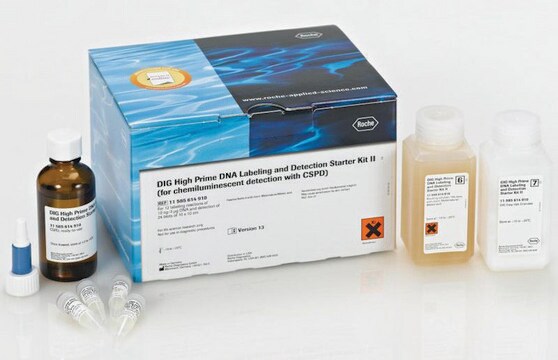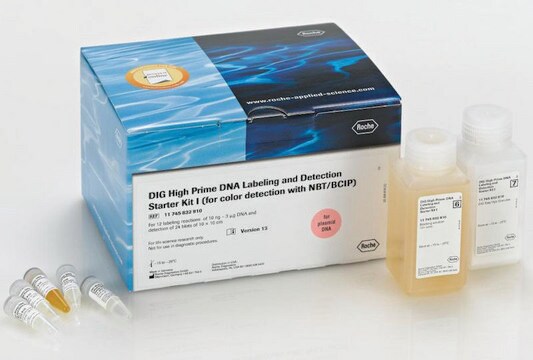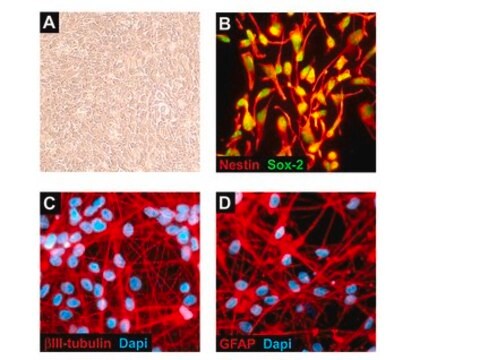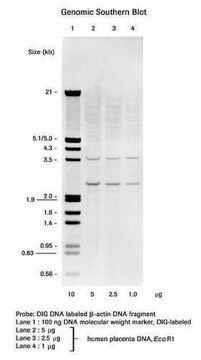LA1-5s
NOTE: Both the cell line and DNA from the cell line may be available for this product. Please choose -1VL or VIAL for cells, or -DNA-5UG for DNA, 6041204, human nerve, Fibroblast-like
Anmeldenzur Ansicht organisationsspezifischer und vertraglich vereinbarter Preise
Alle Fotos(1)
About This Item
UNSPSC-Code:
41106514
Empfohlene Produkte
Biologische Quelle
human nerve
Verpackung
tube of 5 μg 06041204-DNA-5UG
pkg of vial of cells 06041204-1VL
Wachstumsmodus
Not specified
Karyotyp
Not specified
Morphologie
Fibroblast-like
Produkte
Not specified
Rezeptoren
Not specified
Methode(n)
cell culture | mammalian: suitable
Relevante Krankheit(en)
cancer
Versandbedingung
dry ice
Lagertemp.
−196°C
Ursprung der Zelllinie
Human Neural Crest-Derived Non-Neuronal Progenitor
Beschreibung der Zelllinie
LA1-5s is a clonal subline of the cell line LA-N-1 which was established by Seeger et al., (1977) from the primary site of a noncatecholamine-producing neuroblastoma of a 3-year-old female with clinical Stage IV neuroblastoma. The LA1-5s culture consists of large, flat, and tightly adherent cells. They are precursors of Schwann cell/glia/melanocyte lineages arising from the neural crest. This cell line is not tumourigenic in nude mice at a 1,000,000 cell inoculum. The cells can transdifferentiate to a neuroblastic phenotype. The N-myc gene has been reported to be amplified but exhibits very low expression.
LA-N-1 (Sigma catalog number 06041201), LA1-55n (Sigma catalog number 06041203) and LA1-5s (Sigma catalog number 06041204) have been shown to originate from the same patient by STR profiling.
LA-N-1 (Sigma catalog number 06041201), LA1-55n (Sigma catalog number 06041203) and LA1-5s (Sigma catalog number 06041204) have been shown to originate from the same patient by STR profiling.
Nährmedium
EMEM (with non-essential amino acids) and Ham′s F12 (1:1 mixture) + 2 mM Glutamine + 10% Fetal Bovine Serum (FBS)
Subkultur-Routine
For routine maintenance, split cultures every 2-3 weeks at a 1:10 to 1:100 ratio; 8% CO2; 37 °C. The cells are large, flat, fibroblast-like cells that adhere strongly to the substrate. They form a swirling monolayer with no mounding or multilayering when in culture for only a short time, but will increase in density in the stationary phase as the culture is maintained. The cells can be removed from the substrate by rinsing with PBS, then incubating with EDTA/trypsin (at room temperature). Cells will detach in 5-10 minutes. Cells will reattach within several hours after seeding into a new flask. Population doubling time is approximately 2 days. Cells grow best and are most adherent on a plastic substrate in medium at a pH of 6.9-7.2; they do not tolerate more alkaline pH well. Cultures hold well at high density with periodic medium changes, but may also give rise to neuroblastic variants.
Sonstige Hinweise
Additional freight & handling charges may be applicable for Asia-Pacific shipments. Please check with your local Customer Service representative for more information.
Hier finden Sie alle aktuellen Versionen:
Analysenzertifikate (COA)
Lot/Batch Number
It looks like we've run into a problem, but you can still download Certificates of Analysis from our Dokumente section.
Wenn Sie Hilfe benötigen, wenden Sie sich bitte an Kundensupport
Besitzen Sie dieses Produkt bereits?
In der Dokumentenbibliothek finden Sie die Dokumentation zu den Produkten, die Sie kürzlich erworben haben.
Unser Team von Wissenschaftlern verfügt über Erfahrung in allen Forschungsbereichen einschließlich Life Science, Materialwissenschaften, chemischer Synthese, Chromatographie, Analytik und vielen mehr..
Setzen Sie sich mit dem technischen Dienst in Verbindung.







